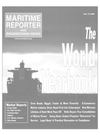
Page 64: of Maritime Reporter Magazine (June 15, 2000)
Read this page in Pdf, Flash or Html5 edition of June 15, 2000 Maritime Reporter Magazine
CAPESIZE
PANAMAX
HANDYMAX
EARbook • DRY Bulk MARKET REPORT
MARKET VALUES FOR BULK CARRIERS 10 YEARS OLD
Fig. 2
SUPPLY
DEMAND
UTILIZATION RATE
SUPPLY, DEMAND AND UTILIZATION RATE
DRY BULK FLEET 10,000 DWT+
Mill, dwt 250 200 150 100 50 0 90 91 92 93 94 95 96 97 98 99 '1 l" 100 70 60
DESTINATION 2000
World shipbuilding's leading trade fair offers you unrivalled opportunities.
Nowhere else will you find so much shipbuilding expertise gathered in one place.
Come to SMM in Hamburg - your destination 2000.
SHIPBUILDING, MACHINERY &
MARINE TECHNOLOGY expanded by about 4.1 million dwt.
About 12 million dwt of bulk carriers are scheduled for delivery in 2000, and the extent of the scrapping program will depend largely by the current and future expectations as to freight rate levels.
However, it is important to remember that about 10 percent of the existing fleet is above the average scrapping age for bulk ships, and it would therefore seem likely to expect that the age ele- ment may have a more noticeable impact on scrapping attitudes in the coming years than before. Taking all likely scenarios into consideration, R.S.
Platou estimates a fleet increase by about two percent between 1999 and 2000.
Sea borne Shipment Trends
Preliminary estimates indicate an approximate one percent increase in world sea borne trade in the dry bulk segment from 1998 to 1999. R.S. Pla- tou noted shorter average distances in coal and steel products trade, and there- fore the tonnage demand increased slightly less than the volumes. Among steel related products R.S. Platou sug- gest a drop of about one percent in iron ore shipments, while coking coal trans- ports remained basically unchanged.
Imports of steel scrap into Asia increased, but into Europe (Turkey), it fell, and preliminary estimates suggest a moderate increase in shipments of fin- ished/semi-finished steel over the year, imports into the U.S. fell from 38 mil- lion tons to about 32 million tons in 1999, and imports into Western Europe fell approximately two million tons.
Conversely, steel imports into Asia rose significantly, more than compensating for these drops.
Grain exports increased by more than five percent in 1999 due to higher import requirements in the Middle East,
Northern Africa and Asia. Among other dry bulk commodities, R.S. Platou recorded an increase of about three per- cent in sea borne trade of forestry prod- ucts.
For the current year, R.S. Platou is expecting the total sea borne trade in dry bulk cargoes to increase in the region of three to four percent. There are no dras- tic trading pattern changes foreseen, so that tonnage demand ought to increase at approximately the same rate as vol- umes. However, it is necessary to take into consideration the trend where minor bulk cargoes, such as forestry and steel products, will be transported in containership. If the trend continues, it will of course have a negative impact on the tonnage demand for Handysize bulk carriers.
By Bjorn Bodding, R.S. Platou's Eco- nomic Research a.s., as excerpted from
The Platou Report 2000.
INTERNATIONAL TRADE FAIR
HAMBURG
September 26-30, 2000
Hamburg Messe
Hamburg Messe und Congress GmbH • St. Petersburger Strasse 1 • D-20355 Hamburg
Phone: +49-40-35 69-21 46, -21 47 • Fax: +49-40-35 69-21 49 • e-mail: [email protected] • www.smm-hamburg.de 60 Circle 267 on Reader Service Card Maritime Reporter/Engineering News

 63
63

 65
65
